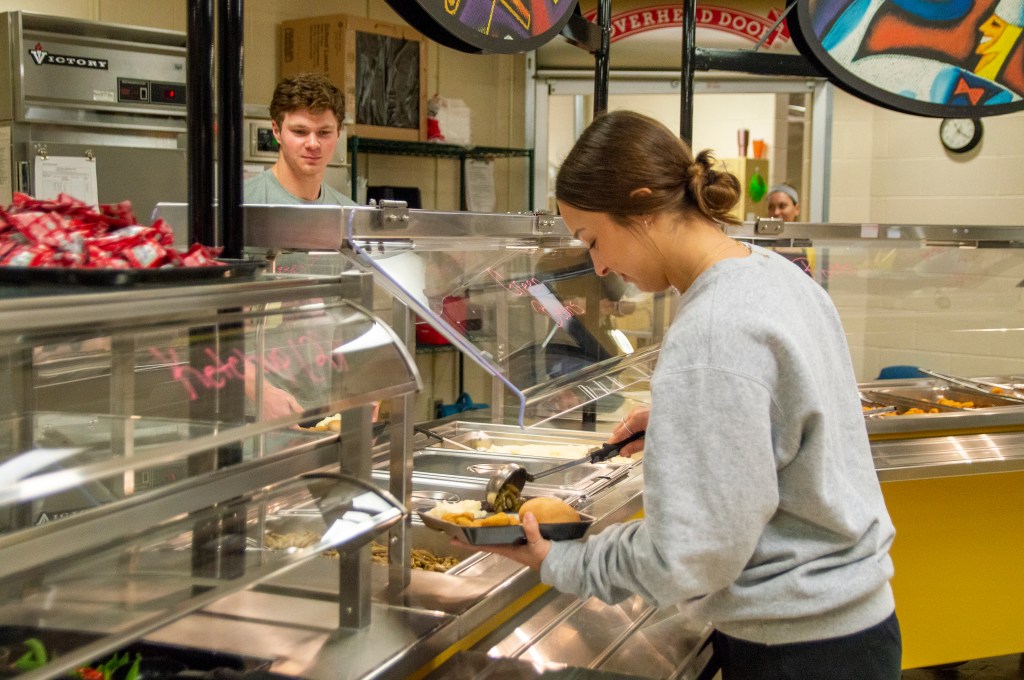Feeding the classes: Local schools experience food supply chain disruptions
Published 10:37 am Thursday, January 13, 2022

- Students at Boyle County High School go through the lunch line, getting their entree of chicken nuggets, mashed potatoes, green beans and rolls. Photo by Fiona Morgan
All schools in the Boyle County and Danville school systems have been experiencing supply chain disruptions since the beginning of the fall 2021 semester.
Boyle County Schools Food Service Director Katie Ellis said the district was prepared for problems at the pandemic’s onset, but they did not have many disruptions until fall 2021. She said this school year has been a perfect storm.
The combination of resuming in-person learning, moving to a different federal meal plan, having to feed more students, labor shortages, and more demand for certain food and supplies has created a crisis for cafeterias.
Ellis said each week they have to adjust their breakfast and lunch menus based on items that are not available. Some popular products they have had trouble getting are Asian chicken, pancakes, yogurt, cereal, juice boxes, eggs, hamburgers, whole grain breakfast items and breads, and all types of chicken.
Danville Schools Food Service Director Tammy Lynn said her district has especially had problems getting chicken. Chicken nuggets being one of the most popular meals, they have had to replace it with other entrees. They’ve also had trouble getting hot dogs and corndogs, and sometimes when they get hot dogs, they can’t get the buns.
“From one week to the next you never know what you’re going to get, if you’re going to get it,” Lynn said.
Both the Boyle County and Danville school districts use Gordon Food Service as their main vendor. An article on GFS’s website states, “Gordon Food Service and all distributors and manufacturers are fighting the same supply chain battles. It plays out differently in different places, but our situations are all similar.”
GFS mainly supplies food from manufacturers to restaurants, healthcare facilities, and places of education. Each week, they release market updates about changes in pricing and availability of food items on their website.
At the Boyle County schools, the cafeteria managers make orders to GFS every Friday. But the website does not always show what items are in or out of stock. So on Mondays, Ellis said she has to make order edits to substitute items that are unavailable. Schools can only order one week in advance due to limited storage space.
Ellis said GFS sends weekly emails with letters from manufacturers explaining their problems. On their website, GFS cites labor shortages and higher product demand as the main obstacles to supply.
“Our supplier has tried every which way they can to supply us some kind of product to feed our kids,” Lynn said.
Sometimes, Ellis said she spends 14 to 16 hours editing orders each week. She also has had to drive to Louisville and Lexington to get products that could not come in shipments.

Students at Boyle County High School go through the lunch line, getting their entree of chicken nuggets, mashed potatoes, green beans and rolls. – Photo by Fiona Morgan
Ellis and Lynn said workers are doing everything they can to get the food they need for students. They are keeping parents and students informed about menu changes on a regular basis.
“Our families have been very understanding and I hope that will continue as we are riding out these challenges,” Ellis said. “We know students love certain meals and we’re doing everything we can to provide those.”
While menu items may be different, they have never not had enough food to feed all their kids. Ellis wants to assure families that they can rely on them to continue serving every student.
Another aspect for Boyle County Schools is that before COVID-19, many students had to pay for meals. Since the pandemic began, they have been able to take advantage of USDA programs that allow them to serve all students at no charge. In the fall of 2021, Boyle County Schools began participating in the Seamless Summer Option of the National School Lunch Program and School Breakfast Program. As a part of the program, they offer healthy meals every school day at no cost to all enrolled students for the 2021-2022 school year. Students participate in these programs without having to pay a fee or submit a household application.
“I think that’s a blessing for our families and it’s wonderful for our program, because we rely on participation,” Ellis said.
During the pandemic lockdowns, Danville and Boyle County schools delivered meals to students at home, which changed their product demand. Federal meal requirements loosened at that time.
School nutrition programs are required to meet nutritional targets on a daily and weekly basis. Foods must be whole grain, meet sodium and protein targets, represent all vegetable subgroups, and other guidelines. When districts cannot buy foods that meet targets, directors must file waivers with the state.
Over the summer of 2021, schools operated under federal summer meal programs, which offered more flexibility in what foods can be served.
“These disruptions to the supply chain occurred at the same time that the USDA moved school nutrition programs back to a more rigorous meal pattern under the National School Lunch Program,” Ellis said.
The program limits the foods that schools can order, which creates more menu volatility and puts more burden on directors to file waivers when they cannot get the necessary food items. Having to order different products that are sometimes more expensive, and don’t qualify for a federal discount, also cuts into their budget.
“There’s really a need for some changes federally in light of what we’re experiencing now,” Ellis said.
She said while the system was built to rely on single vendors, schools should start working with secondary vendors for when they cannot get products from their primary vendor. Boyle schools started with a secondary vendor in January. They have also purchased directly from manufacturers in some cases.
Boyle schools are also starting to do more scratch cooking. They have added chili, homemade spaghetti with sauce, chicken noodle soup, chili cheese nachos, chicken fajitas, chicken alfredo, turkey with gravy, and more recipes that take a scratch cooking approach.
With the start of a new farming year, Ellis is looking for farm-to-school opportunities. However, with the growing season being in the off-school season, those programs will likely be for summer meals.
Due to the COVID-19 public health crisis, both school districts switched to using all paper products, which sky-rocketed in demand.
Danville schools could not get pre-packaged items when delivering food during a lockdown, so workers packaged items themselves.
Both districts are also struggling to find cafeteria workers. Lynn said they are continually short-staffed.
“We can’t get workers; I’ve hired them and they’ll last a day or two, then they’ll quit,” Lynn said.
With no end in sight for the labor shortage, Ellis believes that old ways of operating will not work for schools moving forward. She is working with other food service directors and vendors to figure out long-term solutions.
Both Lynn and Ellis said providers have told them that supply chain problems could continue through the 2022-23 school year.






